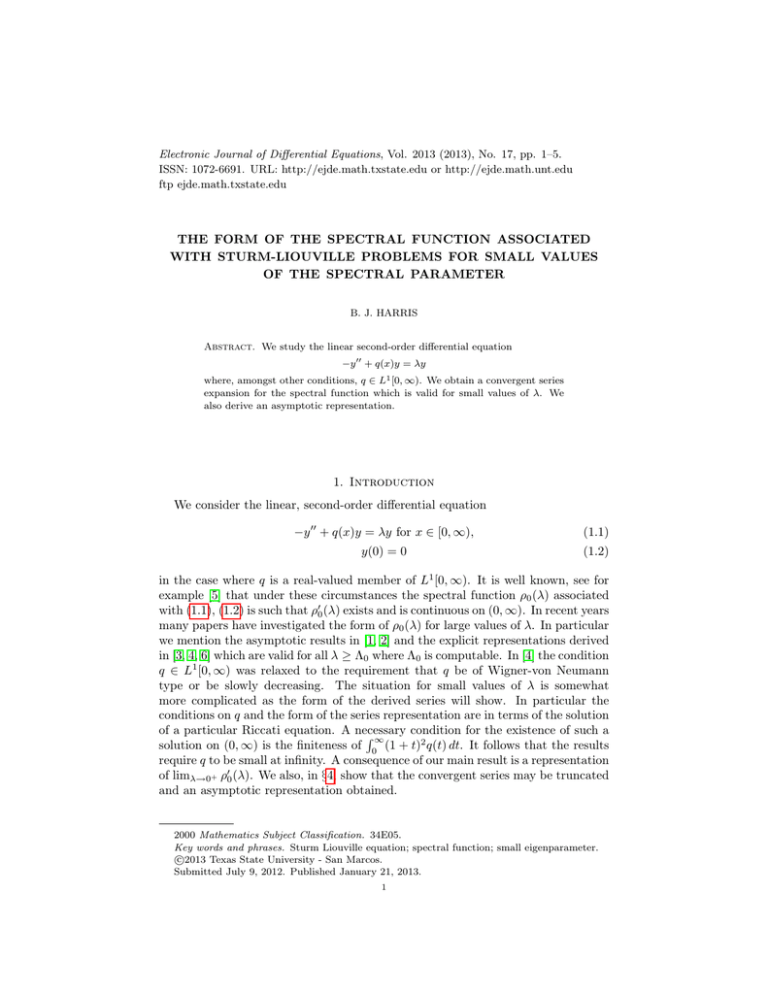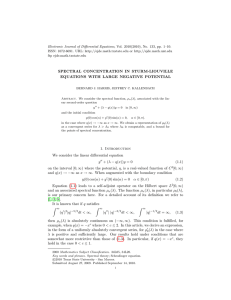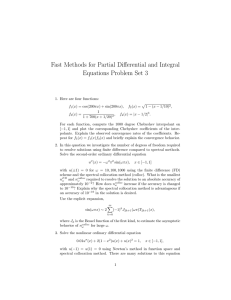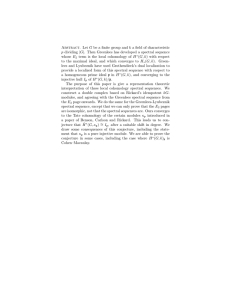Electronic Journal of Differential Equations, Vol. 2013 (2013), No. 17,... ISSN: 1072-6691. URL: or
advertisement

Electronic Journal of Differential Equations, Vol. 2013 (2013), No. 17, pp. 1–5.
ISSN: 1072-6691. URL: http://ejde.math.txstate.edu or http://ejde.math.unt.edu
ftp ejde.math.txstate.edu
THE FORM OF THE SPECTRAL FUNCTION ASSOCIATED
WITH STURM-LIOUVILLE PROBLEMS FOR SMALL VALUES
OF THE SPECTRAL PARAMETER
B. J. HARRIS
Abstract. We study the linear second-order differential equation
−y 00 + q(x)y = λy
where, amongst other conditions, q ∈ L1 [0, ∞). We obtain a convergent series
expansion for the spectral function which is valid for small values of λ. We
also derive an asymptotic representation.
1. Introduction
We consider the linear, second-order differential equation
−y 00 + q(x)y = λy for x ∈ [0, ∞),
(1.1)
y(0) = 0
(1.2)
in the case where q is a real-valued member of L1 [0, ∞). It is well known, see for
example [5] that under these circumstances the spectral function ρ0 (λ) associated
with (1.1), (1.2) is such that ρ00 (λ) exists and is continuous on (0, ∞). In recent years
many papers have investigated the form of ρ0 (λ) for large values of λ. In particular
we mention the asymptotic results in [1, 2] and the explicit representations derived
in [3, 4, 6] which are valid for all λ ≥ Λ0 where Λ0 is computable. In [4] the condition
q ∈ L1 [0, ∞) was relaxed to the requirement that q be of Wigner-von Neumann
type or be slowly decreasing. The situation for small values of λ is somewhat
more complicated as the form of the derived series will show. In particular the
conditions on q and the form of the series representation are in terms of the solution
of a particular Riccati equation. A necessary
condition for the existence of such a
R∞
solution on (0, ∞) is the finiteness of 0 (1 + t)2 q(t) dt. It follows that the results
require q to be small at infinity. A consequence of our main result is a representation
of limλ→0+ ρ00 (λ). We also, in §4, show that the convergent series may be truncated
and an asymptotic representation obtained.
2000 Mathematics Subject Classification. 34E05.
Key words and phrases. Sturm Liouville equation; spectral function; small eigenparameter.
c
2013
Texas State University - San Marcos.
Submitted July 9, 2012. Published January 21, 2013.
1
2
B. J. HARRIS
EJDE-2013/17
2. Results
We assume the existence of a solution, v0 (x), of the Riccati equation
v00 = q(x) − v02
(2.1)
which is defined on [0, ∞) and satisfies
lim xv0 (x) = 0.
(2.2)
x→∞
We further assume that
(1 + t)|v0 (t)| ∈ L1 [0, ∞).
(2.3)
Under these conditions it will be shown that there exists a sequence of functions
{vn (x, λ)} defined recursively as follows:
Z ∞
Rt
1/2
(2.4)
e2iλ (t−x)−2 x v0 (s) ds v0 (t) dt
v1 (x, λ) := 2iλ1/2
x
and
∞
Z
1/2
e2iλ
vn (x, λ) :=
(t−x)−2
Rt
x
v0 (s) ds
n−2
X
2
vn−1
+ 2vn−1
x
vm dt.
(2.5)
m=1
Theorem 2.1. Under conditions (2.1)–(2.3) there exists Λ > 0 so that for λ ∈
(0, Λ)
∞
X
1 1/2
ρ00 (λ) =
λ + Im
vn (0, λ) .
(2.6)
π
n=1
In particular
lim ρ00 (λ) = 0.
(2.7)
λ→0+
Example 2.2. If q(x) := −e−x (1 − e−x ) then it is easy to see that v0 (x) = e−x
satisfies (2.1), (2.2), and (2.3) and limλ→0+ ρ00 (λ) = 0.
Remark 2.3. If v0 satisfies (2.1) then
(1 + t)2 v00 (t) = (1 + t)2 q(t) − (1 + t)2 v0 (t)2
and an integration by parts and (2.2) gives
Z ∞
Z ∞
Z
−v0 (0) − 2
(1 + t)v0 (t) dt =
(1 + t)2 q(t) dt −
0
The boundedness of
0
R∞
0
∞
(1 + t)2 v0 (t)2 .
0
(1 + t)2 q(t) dt now follows from 2.1–(2.3).
Remark 2.4. It is shown below that the requirements (2.1)–(2.3) ensure that v0 (x)
is real-valued.
3. Proof of Theorem 2.1
Following the analysis employed in [5], we seek a solution of the Riccati equation
v 0 = −λ + q − v 2
(3.1)
lim v(x, λ) = iλ1/2 .
(3.2)
1
Im{v(λ)}.
π
(3.3)
which satisfies
x→∞
Then, from [5, (4.4)],
ρ00 (λ) =
EJDE-2013/17
THE FORM OF THE SPECTRAL FUNCTION
3
We try for a solution of (3.1) a series of the form
v(x, λ) = iλ1/2 + v0 (x) +
∞
X
vn (x, λ).
(3.4)
n=1
If term by term differentiation of the terms of the series of (3.4) is justified, substitution of (3.4) into (3.1) leads to a choice of the {vn } such that
v10 + (2iλ1/2 + v0 )v1 = −2iλ1/2 v0
(3.5)
and for n = 2, 3, . . .,
n−2
X
2
vn0 + 2(iλ1/2 + v0 )vn = −vn−1
− 2vn−1
vm .
(3.6)
m=1
It is straightforward to check that the functions defined in (2.4)Pand (2.5) satisfy
(3.5) and (3.6). We now bound the {vn } and show that the series vn0 is absolutely
uniformly convergent on compact subsets of [0, ∞) which is sufficient to justify the
term by term differentiation.
Lemma 3.1. Let
K :=
−2 R t v (s) ds e
x 0
sup
(3.7)
0≤x≤t<∞
and suppose there exists a(x) which is a decreasing member of L1 [0, ∞) such that
|v1 (x, λ)| ≤ λ1/2 a(x)
(3.8)
R
∞
for x ∈ [0, ∞) and λ ∈ [0, Λ] where Λ is so small that 10Kλ1/2 0 a(t) dt ≤ 1 for
λ ∈ [0, Λ]. Then |vn (x, λ)| ≤
λ1/2 a(x)
2n−1
for x ∈ [0, λ) and λ ∈ [0, Λ].
Proof. We use induction on n. When n = 1, the result follows from the hypothesis
(3.8). Suppose now the result is true for all subscripts up to the (n − 1)st. Then
from (2.4), (3.7), and the induction hypothesis:
Z ∞
n−2
X
|vn (x, λ)| ≤ K
|vm | dt
|vn−1 |2 + 2|vn−1 |
x
Z
∞
≤K
x
m=1
2 n−2
X
2
λa(t)
2λa(t)
+ n−2
22n−4
2
1/2
≤
λ
a(x) 1/2 1
λ
2n−1
2n−3
1
dt
m−1
2
m=1
Z
∞
+8
a(t) dt
0
since a(·) is a decreasing function. The result now follows from the
of Λ.
P choice
It may now be seen from the Lemma and (3.6) that the series
vn0 is absolutely
uniformly convergent which justifies the term by term differentiation. To complete
the proof of the theorem we observe that, since v0 (·) ∈ L1 [0, ∞), there exists a K
which satisfies (3.7) and also, from (2.4), that
Z ∞
1/2
|v1 (x, λ)| ≤ 2λ K
|v0 (t)| dt.
x
We now choose a(x) := 2K
Z ∞
Z
a(x) dx =
0
R∞
0
x
∞
|v0 (t)| dt and note that
Z ∞
Z
2K
|v0 (t)| dt dx = 2K
x
0
∞
t|v0 (t)| dt.
4
B. J. HARRIS
EJDE-2013/17
The first part of the theorem now follows.
It remains to show that, under the assumptions (2.1)–(2.3), v0 is real-valued.
Suppose not; if v0 (t) = u(t) + iw(t) then upon substitution into (2.1) and the
separation of real and imaginary parts we see that
w0 = −2uw
whence
w(t) = Ce−2
Rt
0
u(s) ds
Rt
The requirement limt→∞ v0 (t) = 0 then requires either C = 0 or limt→∞ 0 u(s) ds =
∞. But the latter case contradicts (2.3) which requires that (1 + t)v0 (t) and hence
(1 + t)u(t) ∈ L1 [0, ∞), so the only possibility is that v0 is real-valued.
4. An asymptotic expansion
The bounds derived in Lemma 3.1 lead to estimates for the {vn } which show that
P∞
n=1 vn (x, λ) is uniformly, absolutely convergent for x ∈ [0, ∞) and 0 ≤ λ < Λ
for some Λ which is, in principle at least, computable. In terms of λ however
the bounds are all of order λ1/2 . We now show that the terms of the series are
decreasing asymptotically with increasing powers of λ.
Lemma 4.1. With K as in (3.7) and with v1 satisfying (3.8) there exist sequences
of constants {Cn } and {Λn } so that for x ∈ [0, ∞) and 0 ≤ λ ≤ Λn ≤ Λn−1
|vn (x, λ)| ≤ Cn λn/2 a(x).
(4.1)
Proof. We proceed by induction. From (2.5),
Z ∞
Rt
|v2 (x, λ)| ≤
e−2 x v0 (s) ds |v1 (t, λ)|2 dt
x
Z ∞
Z ∞
≤ λK
a(t)2 dt ≤ λa(x)K
a(t) dt
x
0
Suppose the result is true up to n ≥ 2, then from (2.5):
Z ∞
n−1
X
|vn+1 (x, λ)| ≤ K
|vn |2 + 2|vn |
|vm | dt
x
Z
m=1
∞
≤K
Cn2 λn a(t)2 + 2Cn λn/2 a(t)
x
n−1
X
Cm λm/2 a(t) dt
m=1
Z
n−1
X
n−1
m−1 n+1
Cm λ 2
≤ Kλ 2 a(x) Cn 2 λ − 2Cn
m=1
∞
a(t) dt
0
since the Λn form a decreasing sequence. The result now follows.
In consequence of Lemma 4.1 we have that for every N ,
N
N +1 X
1 1/2
ρ00 (λ) =
λ + Im
vn (0, λ) + O λ 2
π
n=1
as λ → 0+ and, in particular,
Z ∞
Rt
λ1/2 ρ00 (λ) =
1+2
cos(2λ1/2 t)e−2 0 v0 (s) ds v0 (t) dt + O(λ)
π
0
as λ → 0+ .
EJDE-2013/17
THE FORM OF THE SPECTRAL FUNCTION
5
References
[1] M. S. P. Eastham; The asymptotic nature of the spectral functions in Sturm-Liouville problems with continuous spectra. J. Math. Anal. Appl. 213 (1997), 573-582.
[2] M. S. P. Eastham; On the location of spectral concentration for Sturm-Liouville problems
with rapidly decaying potential. Mathematika 45 (1998), 25-36.
[3] D. J. Gilbert, B. J. Harris; Bounds for the spectral concentration of Sturm-Liouville problems.
Mathematica 47 (2000), 327-337.
[4] D. J. Gilbert, B. J. Harris, S. M. Riehl; The spectral function for Sturm-Liouville problems
where the potential is of von-Neumann-Wigner type or slowly decaying. J. Diff. Eqns. 201
(2004), 139-159.
[5] D. J. Gilbert, B. J. Harris, S. M. Riehl; Higher derivatives of spectral functions associated
with one-dimensional Schrödinger operators. Operator Theory: Advances and Applications
186 (2008), 217-228.
[6] B. J. Harris; The form of the spectral functions associated with Sturm-Liouville problems
with continuous spectra. Mathematika 44 (1997), 149-161.
Bernie J. Harris
Department of Mathematical Sciences, Northern Illinois University, DeKalb, IL 601152888, USA
E-mail address: harris@math.niu.edu




